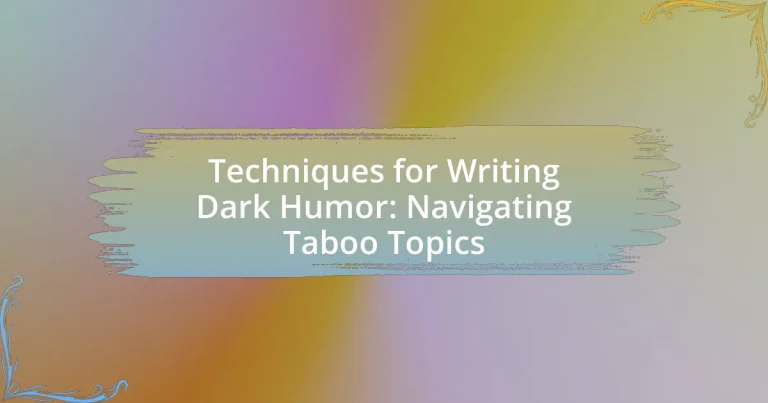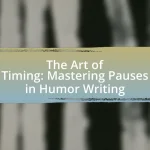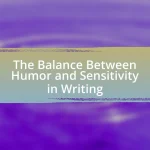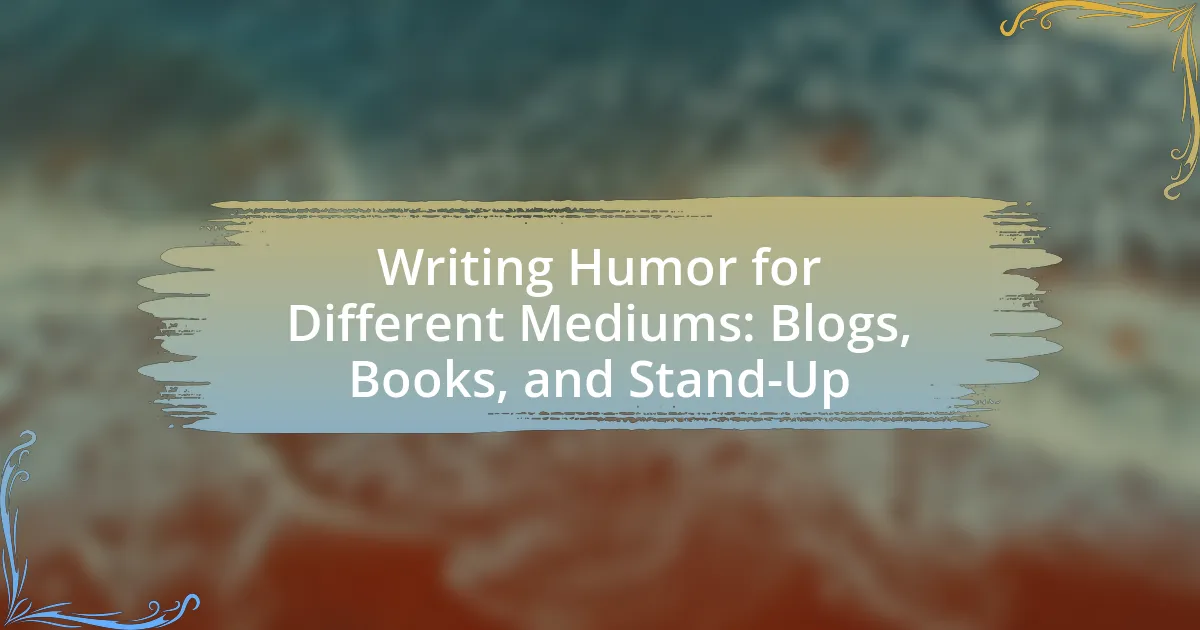The article focuses on techniques for writing dark humor, emphasizing the importance of navigating taboo topics with sensitivity and wit. It outlines fundamental principles such as the balance of irony, shock value, and audience context, while distinguishing dark humor from other humor types. Key elements include the use of morbid subjects to provoke thought and laughter, as well as the ethical considerations writers must keep in mind to avoid offending audiences. The article also provides practical strategies for effectively addressing sensitive subjects, gauging audience reactions, and maintaining ethical standards in dark humor writing.
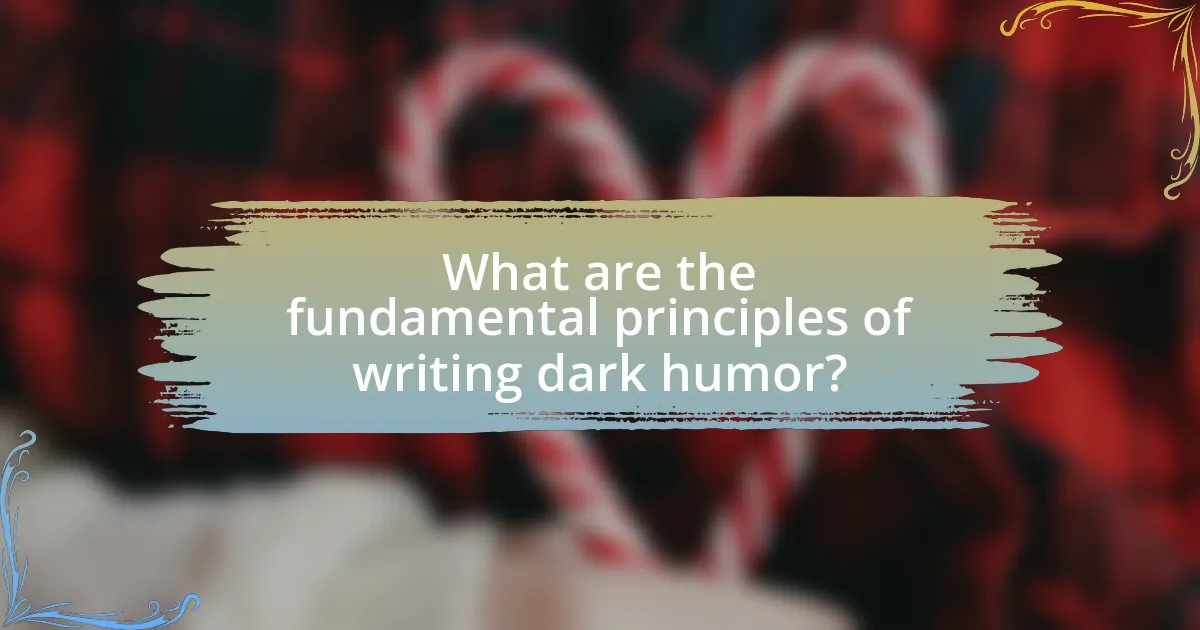
What are the fundamental principles of writing dark humor?
The fundamental principles of writing dark humor include the careful balance of taboo subjects, irony, and the element of surprise. Writers must navigate sensitive topics by using irony to highlight the absurdity of serious situations, which can create a comedic effect. For instance, the use of unexpected punchlines can subvert audience expectations, making the humor more impactful. Additionally, understanding the audience’s boundaries is crucial; humor that crosses too far into insensitivity can alienate or offend. Historical examples, such as the works of comedians like George Carlin and shows like “The Addams Family,” illustrate how dark humor can effectively address societal issues while maintaining comedic value.
How does dark humor differ from other types of humor?
Dark humor differs from other types of humor primarily in its focus on subjects that are typically considered taboo, such as death, illness, or tragedy. While most humor aims to elicit laughter through light-hearted or relatable content, dark humor intentionally juxtaposes serious themes with comedic elements, often provoking discomfort or reflection. This type of humor can serve as a coping mechanism, allowing individuals to confront difficult realities in a less threatening manner, as evidenced by its prevalence in various forms of media during times of societal stress, such as war or economic downturns.
What are the key elements that define dark humor?
Dark humor is characterized by its use of morbid, taboo, or distressing subjects to elicit laughter. Key elements include irony, which juxtaposes serious themes with comedic elements; shock value, which provokes strong emotional reactions; and a sense of transgression, where societal norms are challenged. These elements allow dark humor to explore sensitive topics, such as death or suffering, in a way that can provide relief or provoke thought. Research indicates that dark humor can serve as a coping mechanism, helping individuals process difficult emotions and experiences, as noted in studies on humor psychology.
Why is context important in dark humor?
Context is crucial in dark humor because it shapes the audience’s understanding and reception of the joke. The effectiveness of dark humor relies on the situational background, cultural norms, and the emotional state of the audience, which can either enhance or diminish the intended comedic effect. For instance, a joke about a sensitive topic may be perceived as offensive or inappropriate without the right context, while the same joke can be seen as insightful or humorous when framed within a specific narrative or social commentary. This highlights the importance of context in determining whether dark humor is accepted or rejected by the audience.
What role do taboo topics play in dark humor?
Taboo topics serve as a catalyst for dark humor by challenging societal norms and provoking strong emotional reactions. Dark humor often relies on the juxtaposition of sensitive subjects, such as death, illness, or social taboos, to elicit laughter through discomfort. This technique allows comedians and writers to explore complex themes and provide commentary on human experiences, often revealing underlying truths about society. Research indicates that humor can serve as a coping mechanism, helping individuals process difficult emotions associated with taboo subjects, thereby reinforcing the role of taboo topics in dark humor as both a source of comedy and a means of psychological relief.
How can taboo subjects enhance comedic effect?
Taboo subjects can enhance comedic effect by creating a sense of surprise and subverting societal norms. When comedians address topics that are typically considered off-limits, they challenge audiences’ expectations, leading to heightened emotional responses. This technique relies on the incongruity theory of humor, which posits that humor arises from the juxtaposition of conflicting ideas. For example, research by Peter McGraw and his colleagues in the “Benign Violation Theory” suggests that humor occurs when a situation is simultaneously perceived as a violation of social norms and benign, allowing audiences to laugh at discomforting topics. Thus, taboo subjects can serve as a powerful tool in comedy, eliciting laughter through their unexpected and provocative nature.
What are the risks associated with using taboo topics?
Using taboo topics in writing can lead to significant risks, including alienation of audiences, potential backlash, and legal repercussions. Alienation occurs when content offends or disturbs readers, causing them to disengage or react negatively. For instance, a survey by the Pew Research Center found that 60% of respondents felt uncomfortable with humor that touches on sensitive subjects like race or mental health. Backlash can manifest in public criticism or social media outrage, which can damage an author’s reputation and career. Additionally, legal repercussions may arise if content is deemed defamatory or incites hate speech, as seen in various lawsuits against comedians and writers. These risks highlight the need for careful consideration when addressing taboo topics in humor.
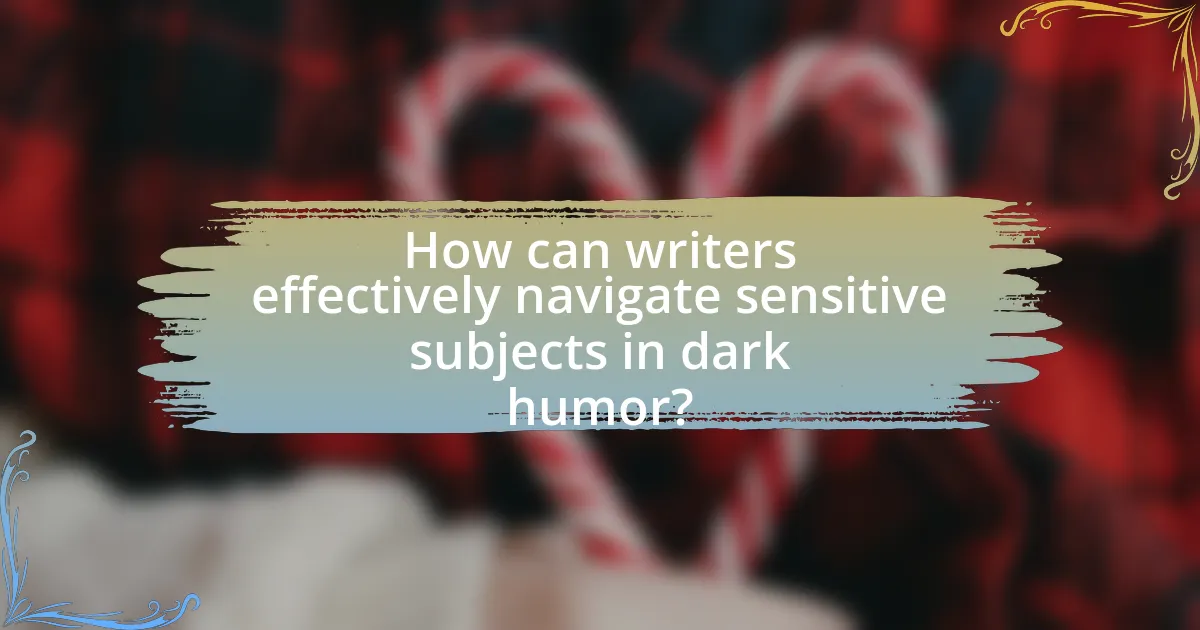
How can writers effectively navigate sensitive subjects in dark humor?
Writers can effectively navigate sensitive subjects in dark humor by employing a careful balance of empathy and wit. This involves understanding the potential impact of their words on various audiences while crafting jokes that highlight absurdities without trivializing real suffering. For instance, comedians like Louis C.K. have successfully tackled sensitive topics by using personal anecdotes that resonate with shared human experiences, allowing audiences to find humor in discomfort. Additionally, research indicates that humor can serve as a coping mechanism, helping individuals process trauma, as noted in the study “The Role of Humor in Coping with Stress” by Martin and Lefcourt. This demonstrates that when executed thoughtfully, dark humor can foster connection and understanding rather than alienation.
What strategies can be employed to approach taboo topics sensitively?
To approach taboo topics sensitively, one effective strategy is to employ empathy and active listening. This involves understanding the perspectives and feelings of those affected by the topic, which can help in framing discussions in a respectful manner. Research indicates that empathetic communication fosters a safe environment for dialogue, allowing individuals to express their thoughts without fear of judgment. Additionally, using inclusive language and avoiding stereotypes can further mitigate potential offense, as studies show that language shapes perceptions and can either reinforce or challenge societal norms. By prioritizing sensitivity and awareness, writers and speakers can navigate taboo subjects more effectively.
How can writers gauge audience sensitivity to taboo subjects?
Writers can gauge audience sensitivity to taboo subjects by conducting audience research and utilizing feedback mechanisms. Surveys and focus groups can reveal audience attitudes toward specific topics, allowing writers to understand boundaries and preferences. For instance, a study by the Pew Research Center found that 61% of Americans believe that humor can be used to address sensitive issues, indicating a potential openness to dark humor, but responses can vary significantly based on demographics. Additionally, monitoring social media reactions and engaging in discussions can provide real-time insights into audience sentiments, helping writers adjust their content accordingly.
What are some techniques for balancing humor and sensitivity?
To balance humor and sensitivity, one effective technique is to understand the audience’s context and boundaries. This involves researching the demographic and cultural backgrounds of the audience to gauge what topics may be sensitive. Additionally, using self-deprecating humor can create a relatable atmosphere, allowing the audience to feel more comfortable. Another technique is to employ irony or satire, which can provide a humorous perspective on serious topics without being offensive. Furthermore, testing material with a small, diverse group before wider dissemination can help identify potential pitfalls. These methods are supported by studies indicating that humor can be a tool for coping with difficult subjects when approached thoughtfully, as seen in research by the University of California, which highlights the importance of audience awareness in humor effectiveness.
What are the ethical considerations in writing dark humor?
The ethical considerations in writing dark humor include sensitivity to the subject matter, the potential impact on marginalized groups, and the intent behind the humor. Writers must recognize that dark humor often addresses serious topics such as death, trauma, or mental illness, which can be triggering or offensive to some audiences. Research indicates that humor can reinforce stereotypes or perpetuate stigma, particularly when it involves vulnerable populations. Therefore, it is crucial for writers to assess whether their jokes contribute to harmful narratives or provide a means of coping and understanding. Additionally, the context in which dark humor is presented can significantly influence its reception; what may be acceptable in one setting could be deeply inappropriate in another.
How can writers avoid crossing the line into offensive territory?
Writers can avoid crossing the line into offensive territory by understanding their audience and employing sensitivity in their content. This involves researching cultural contexts and being aware of the potential impact of their words on different groups. For instance, studies show that humor can be perceived differently based on cultural backgrounds, which highlights the importance of tailoring content to avoid alienation or harm. Additionally, writers should seek feedback from diverse perspectives before publishing, as this can help identify potentially offensive material.
What guidelines can help maintain ethical standards in dark humor?
To maintain ethical standards in dark humor, creators should prioritize sensitivity to the audience’s experiences and avoid targeting marginalized groups. This approach ensures that humor does not perpetuate harm or reinforce negative stereotypes. Research indicates that humor can be a powerful tool for social commentary, but it must be wielded responsibly; for instance, a study by the University of Kent found that humor that acknowledges the pain of others can foster empathy rather than alienation. Additionally, creators should consider the context in which the humor is presented, ensuring it aligns with the values of inclusivity and respect. By adhering to these guidelines, dark humor can be crafted in a way that is both impactful and ethically sound.
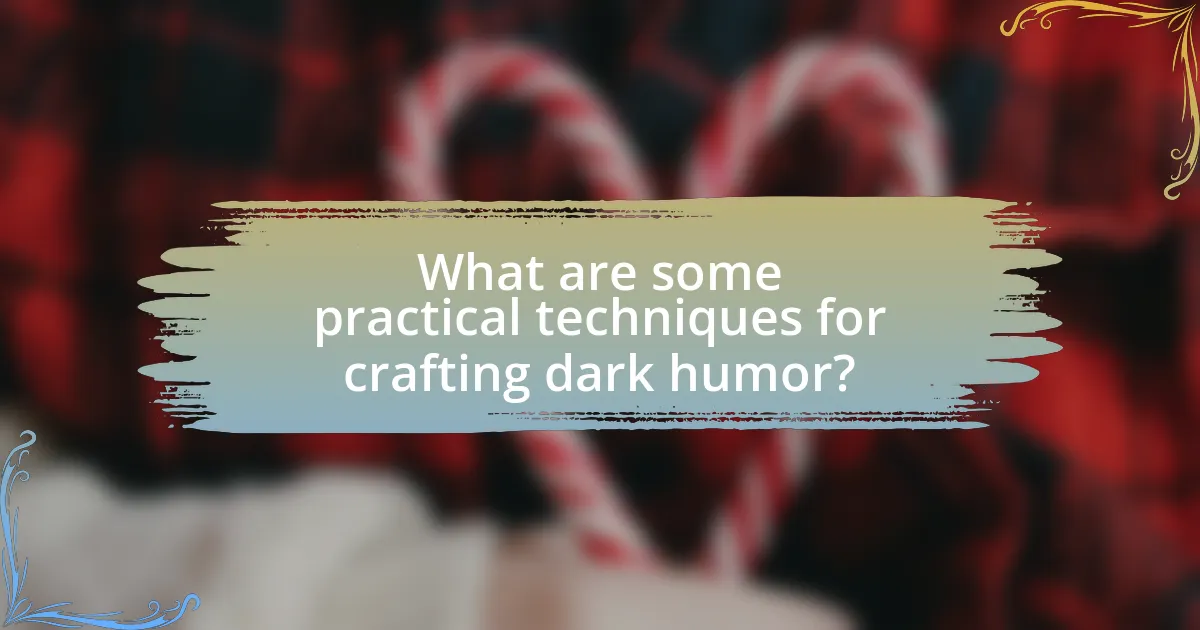
What are some practical techniques for crafting dark humor?
To craft dark humor effectively, one can employ techniques such as juxtaposition, irony, and subversion of expectations. Juxtaposition involves placing contrasting ideas side by side, highlighting the absurdity in serious situations, which can elicit laughter. Irony allows the writer to present a situation in a way that contradicts the expected outcome, creating a humorous twist. Subversion of expectations plays on the audience’s preconceived notions, leading them to anticipate one outcome before delivering a punchline that defies that expectation. These techniques are supported by the understanding that humor often arises from discomfort, as noted in studies on humor psychology, which suggest that laughter can serve as a coping mechanism for dealing with taboo subjects.
How can writers develop their unique voice in dark humor?
Writers can develop their unique voice in dark humor by embracing authenticity and personal experiences while experimenting with language and structure. Authenticity allows writers to draw from their own perspectives and emotions, making their humor resonate more deeply with audiences. For instance, using personal anecdotes related to taboo topics can create a relatable yet edgy narrative. Additionally, experimenting with language—such as employing irony, wordplay, and unexpected punchlines—can enhance the distinctiveness of their voice. Research indicates that successful dark humor often relies on subverting expectations, which can be achieved through clever twists in storytelling. By combining these elements, writers can cultivate a voice that is both unique and impactful in the realm of dark humor.
What writing exercises can help enhance dark humor skills?
Writing exercises that can enhance dark humor skills include creating character profiles that explore morally ambiguous traits, writing short stories that juxtapose light-hearted scenarios with dark themes, and practicing punchline development by crafting jokes that play on societal taboos. These exercises encourage writers to delve into complex emotions and societal norms, allowing for a nuanced approach to humor. For instance, analyzing successful dark humor in literature and film, such as the works of authors like Kurt Vonnegut or shows like “The Office,” can provide insight into effective techniques. Engaging in these exercises fosters a deeper understanding of timing, context, and the delicate balance required to navigate sensitive topics while eliciting laughter.
How can feedback improve dark humor writing?
Feedback can significantly enhance dark humor writing by providing insights into audience reactions and sensitivities. Writers can refine their material based on constructive criticism, which helps identify what resonates and what may offend. For instance, feedback can reveal whether a joke effectively balances humor with the gravity of taboo subjects, ensuring that the intent is clear and the humor is appropriate. Studies in humor theory suggest that understanding audience perception is crucial for successful comedic writing, particularly in sensitive areas. By incorporating feedback, writers can adjust their tone, timing, and content to better align with audience expectations, ultimately improving the effectiveness of their dark humor.
What are common pitfalls to avoid when writing dark humor?
Common pitfalls to avoid when writing dark humor include insensitivity to the subject matter, lack of context, and failing to consider the audience’s perspective. Insensitivity can lead to offense, as humor that trivializes serious issues may alienate or hurt individuals affected by those topics. Lack of context can result in misunderstandings, where the intent behind the humor is lost, making it appear cruel rather than comedic. Additionally, failing to consider the audience’s perspective can lead to jokes that miss the mark, as humor is subjective and varies widely among different groups. These pitfalls highlight the importance of thoughtful consideration in crafting dark humor that resonates without causing harm.
How can overstepping boundaries affect a writer’s reputation?
Overstepping boundaries can significantly damage a writer’s reputation by alienating audiences and provoking backlash. When writers tackle sensitive subjects without regard for the feelings or perspectives of affected groups, they risk being labeled as insensitive or offensive. For instance, a study published in the Journal of Communication found that humor perceived as crossing ethical lines can lead to public outrage and loss of credibility. This negative perception can result in decreased readership, loss of professional opportunities, and a tarnished public image, ultimately affecting a writer’s career longevity and influence in their field.
What are the signs that dark humor may not be landing well?
Signs that dark humor may not be landing well include visible discomfort among the audience, such as frowns, silence, or awkward laughter. These reactions indicate that the humor is not resonating positively, as studies show that humor often relies on shared understanding and context. When the audience appears disengaged or offended, it suggests that the boundaries of acceptable humor have been crossed, leading to a disconnect between the speaker and the listeners.
What tips can help writers succeed in dark humor?
Writers can succeed in dark humor by balancing sensitivity with wit. This involves understanding the boundaries of taboo topics while crafting jokes that provoke thought without causing offense. Successful dark humor often relies on clever wordplay, irony, and subverting expectations, which can engage audiences while addressing serious subjects. For instance, comedians like Louis C.K. and Sarah Silverman have effectively used personal experiences and societal observations to create humor that resonates, demonstrating that context and delivery are crucial in dark humor.
How can writers effectively test their dark humor with audiences?
Writers can effectively test their dark humor with audiences by utilizing live performances, focus groups, and online platforms. Live performances allow immediate audience reactions, providing real-time feedback on the humor’s impact. Focus groups can offer in-depth discussions about specific jokes, helping writers gauge sensitivity and acceptance. Online platforms, such as social media or comedy forums, enable writers to share content and analyze engagement metrics, such as likes, shares, and comments, to assess audience reception. These methods are supported by research indicating that audience feedback is crucial for refining comedic material, particularly in sensitive genres like dark humor.
What resources are available for improving dark humor writing skills?
Resources available for improving dark humor writing skills include books, online courses, and workshops specifically focused on humor writing. Notable books such as “The Comedy Bible” by Judy Carter and “Writing Comedy” by John Vorhaus provide foundational techniques and insights into humor, including dark humor. Online platforms like MasterClass offer courses from established comedians, such as Steve Martin, which cover various aspects of humor writing. Additionally, workshops hosted by comedy clubs or writing organizations often focus on humor, allowing writers to practice and receive feedback on their dark humor material. These resources collectively enhance understanding and execution of dark humor writing.
